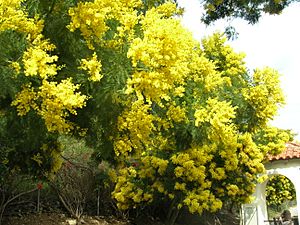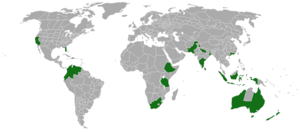Black wattle facts for kids
Quick facts for kids Black wattle |
|
|---|---|
 |
|
| Scientific classification | |
| Genus: |
Acacia
|
| Species: |
decurrens
|
 |
|
| Occurrence data from AVH | |
| Synonyms | |
The Black Wattle (Acacia decurrens) is a type of tree or shrub. It grows naturally in eastern New South Wales, Australia. This includes places like Sydney, the Greater Blue Mountains Area, and the Hunter Region. You can also find it south-west into the Australian Capital Territory. This plant can grow quite tall, from 2 to 15 meters (7 to 50 feet). Its flowers usually appear from July to September.
Black Wattle is grown in many parts of Australia and other countries. It has spread and now grows wild in most Australian states. You can also find it in Africa, the Americas, Europe, New Zealand, the Pacific islands, the Indian Ocean area, and Japan.
Contents
What Does the Black Wattle Look Like?
The Black Wattle is a tree that grows very quickly. It can reach heights of 2 to 15 meters (7–50 feet). Its bark is usually brown to dark grey. It can be smooth or have deep cracks running along it. The branches have special ridges that help identify this species. The tips of its young leaves are often yellow.
How to Spot a Black Wattle
The leaves grow in an alternating pattern. They are dark green on both sides. The base of each leaf stalk is swollen. The leaf blade is "bipinnate," which means it's divided into many smaller leaflets. There are 15 to 45 pairs of these tiny leaflets. Each leaflet is 5–15 mm long and very narrow, about 0.4–1 mm wide. They are straight, shiny, and usually smooth.
The flowers are small and yellow or golden-yellow. They look very soft and fluffy. They grow in dense clusters along the stems. These flower clusters are 5–7 mm long and 60–110 mm long. The flowers have both male and female parts and smell nice. They have five petals, five sepals, and many noticeable stamens.
After the flowers, seed pods grow. These pods are ready between November and January. The seeds are dark brown or reddish-brown to black. They are found inside flat, smooth pods. These pods are 20–105 mm long and 4–8.5 mm wide. They open up with two halves to release the seeds. When young, the pods are hairy, but they become smooth as they grow.
The Many Names of Black Wattle
This plant has many common names. People call it black wattle, early green wattle, or Sydney green wattle. In the local Dharawal language, it is called Boo'kerrikin. Early settlers in some areas called it "Wat-tah" or green wattle. It's also known as early green wattle in the Sydney area. This is because it flowers in winter, earlier than similar plants. Some of these similar plants include Parramatta wattle and late black wattle. In South Africa, where it has spread widely, some people call it "green cancer." Other names include acacia bark, wattle bark, and golden teak.
Where Does the Black Wattle Grow?
The Black Wattle is native to the Tablelands of New South Wales and Victoria in Australia. It prefers temperate areas, from the coast to cooler inland regions. However, it does not like very dry or hot inland areas. It grows well in places that get a lot of rain, about 600-1400 mm (24-55 inches) per year. It can handle many different conditions. In New South Wales, it grows in woodlands and dry forests. There, it can be found with trees like grey gum and narrow-leaved ironbark.
Where it has spread outside its native areas, Black Wattle often grows along roadsides. You can also find it near creeks and in disturbed or unused areas. It also grows in places where bushlands and open woodlands have been changed by humans.
It was planted a lot in New South Wales. Because of this, it can be hard to tell if it's native or has spread in areas close to its original home. The species has also spread to other Australian states like Queensland, Victoria, and Tasmania. It grows best in shale and sandstone soils. These soils should have medium nutrients and drain water well.
Black Wattle in Nature
The dark brown or black seeds are the main way this plant reproduces. Ants or birds can help spread these seeds. The seeds can also stay in the soil for a long time, forming a "seedbank." After a bushfire, new seedlings usually grow very quickly. This plant can also grow in areas that have been disturbed. Black Wattle trees can live for 15 to 50 years.
Some animals eat parts of the Black Wattle. Sulphur-crested cockatoos, for example, eat the unripe seeds. The leaves are food for the caterpillars of several butterfly species. These include the double-spotted line blue and the imperial hairstreak. The wood also provides food for the larvae of certain jewel beetle species.
What is Black Wattle Used For?
Black Wattle has many uses. It can be used to make chemical products and for managing the environment. Its wood is also useful. The flowers are edible and can be used in fritters. The tree also produces an edible gum from its trunk. This gum can be used like gum arabic, for example, in making fruit jelly.
The bark of the Black Wattle is rich in a substance called tannin, containing about 37–40%. Tannin is used in many industries. The flowers are used to make a yellow dye. The seed pods can be used to make a green dye. A natural chemical called kaempferol gives the flowers their yellow color. Black Wattle has also been grown for firewood. It is also planted as a fast-growing windbreak or shelter tree.
Growing Black Wattle
The Black Wattle is easy to grow and grows very fast. It can be a good choice for large gardens and parks. It can act as a shelter tree or a beautiful specimen tree. When it's flowering, the tree can look very impressive. You can start growing Black Wattle by soaking its seeds in warm water. Then, you can plant them outdoors. The seeds can stay able to grow for many years.
Studies have shown that having these types of wattles (like Black Wattle) in an area can help. They can reduce the number of noisy miners. Noisy miners are aggressive birds that can scare away smaller birds from gardens and bushland. So, planting Black Wattles can help create "green corridors" and restore natural areas.
Images for kids
See also
 In Spanish: Acacia decurrens para niños
In Spanish: Acacia decurrens para niños





